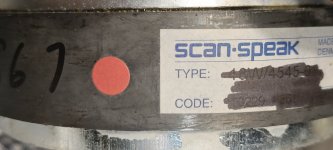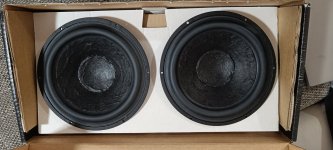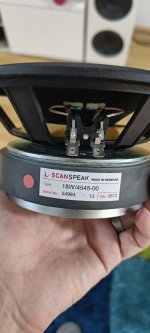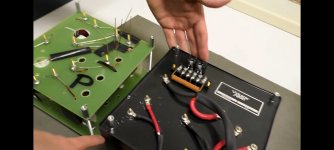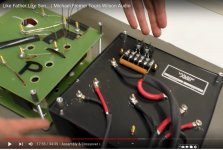Regarding 4ohm midrange VC- I believe you just have two options- believe what I'm saying or believe what you are thinking. With all respect to other forum member- yours(complete) incompetence to interpret measurements and at least know basic of passive filtering lead to wrong assumptions. when there is some uncleariness in your assumption you point problem from your own abilities to outside. The good point to start is some loudspeakers design cook books. Once you learn basics , strange and "wrong" things slides in to places. for example how aditional resistance afect electrical impedance ,or what is microphone overdrive. the thread is valuable for some moderatley advanced readers who understand basics. for others is complete "missunderstanding" . have fun to learn things and keep enjoing forum! 🙂SMABB,
I wrote ( No Wilson speaker) They are some speakers with crossovers of the first order In the measurements from elvikai, I am not surprised by the high level, but the 10dB difference between the woferr and the tweeter He also writes that the woofwr is 4 ohm, but the impedance curve shows a prime example of an 8 ohm speaker. The minimum there is 7 Ohm. The whole measurement thing is confusing.
Yes, we are all dumb and ignorant and have never properly(!) measured drivers and designed systems. On top of all that, we are totally incapable of reverse engineering filter-driver combo's.
Guys, I believe the Watt3 Seas Driver was a 4Ohm and in Watt5/6/7 Scan Speak is a 8Ohm driver. So the Watt3 can't be used with Puppy 5..
Last edited:
Guys, this is technical forum, not church. 😀 If somoene have some reason not to trust what i say- for the first one who donate 400usd to Diyaudio forum I will make Thiel small measurements( aded mass) , make fre air FS, impedanse and nearfield and farfield frequency measurements on 0'/15'/40' angles and AGAIN dismantle whole wp6 and wp8 midrange drivers, measure VC diameter height anf thickness of VC and its material, ant make movie where you can see real action of those steps. whats not to like? We all will have fun,learn some things and suport this wonderful diyaudo community forum.Guys, I believe...
Hehe, I get you. I'm calibration engineer and audio repair tech for over 25 years and btw, I'm not religious. 😉 I just saw the impedance plot and it drops not under 5 Ohm.. but crossover has some serial resistor inside so it must be a 4Ohm driver..
I tell you what there is not to like in the offer: the original question was a x/o schematic. We have lots of text, but still nothing that is even remotely looking like the info we need for proper reverse engineering of the x/o. T/S params have absolutely nothing to do with the original question.
What we need is raw 5db/div. (max 1/20 smoothened) inbox-driver transfer function measurements (woof/mid/tweet), in-box filtered driver measurements and in box unfiltered .zma data of each driver. One can than use the filtered inbox responses of each leg as respective targets for filter cloning.
What we need is raw 5db/div. (max 1/20 smoothened) inbox-driver transfer function measurements (woof/mid/tweet), in-box filtered driver measurements and in box unfiltered .zma data of each driver. One can than use the filtered inbox responses of each leg as respective targets for filter cloning.
So..I've checked my Watt 5.1 for the driver, it's a 4Ohm 18W/4545-0. The + terminal goes to driver's negative connector (revers polarity). In the Watt's enclosure is full of poliester wadding. I was sure there's a sheet of neoprene on inner walls only. Watt 3 was without any wadding or am I wrong? Here's the Scan Speak driver.
Attachments
My firm belief is, you have the figures correct but correlated to wrong groups.Guys, I believe the Watt3 Seas Driver was a 4Ohm and in Watt5/6/7 Scan Speak is a 8Ohm driver. So the Watt3 can't be used with Puppy 5..
Wilson used the standard Seas CA17RCY in the first three incarnations, which was only available in 8 Ohm but had a sensitivity of 91 dB/W.
The Scan Speak drivers was in their standard 8 Ohm version sufficiently lower at 88-89 dB/W, which was adjusted among other things by using a specially developed version with a nominal 4 Ohm. Confirmed by the measurement of JRjunior.
I do not think that its etchical or educational in that matter to provide stolen intelectual property (xover schematics). I gave some info over years and I just watching this thread and trying to point back to the road when you, guys turning off the road. When I repeatidly say same thing 4 times and people still do not trust -whats the point of tryintg to point to right direction? Anyway have fun with this "project", I will not post here anymore and unfollow this thread not to get new notifications.I tell you what there is not to like in the offer: the original question was a x/o schematic. We have lots of text, but still nothing that is even remotely looking like the info we need for proper reverse engineering of the x/o.
If you import the measurements into a simulator you can get a simulator to closely match the original design.
Some of these loudspeaker designers are on the spectrum and they try to find ways to improve the dynamic performance which the crossover typically influences.
For example they use damping resisters shunted directly cross the driver. A typical value is 39R but the value could be 20R or less for a woofer. What you get is a damped filter with a modified ripple, group delay and impedance transfer function.
This will and does infer a shift in the dynamic behaviour of the loudspeaker motor due to controlling influence of the pure resistance of the electro mechanical elements of the motor.
Subjectively this might be perceived as improved transient behaviour or overhang of a woofer.
Some designers also use custom drives with a small secondary coil to act as a shorted turn.
Some of these loudspeaker designers are on the spectrum and they try to find ways to improve the dynamic performance which the crossover typically influences.
For example they use damping resisters shunted directly cross the driver. A typical value is 39R but the value could be 20R or less for a woofer. What you get is a damped filter with a modified ripple, group delay and impedance transfer function.
This will and does infer a shift in the dynamic behaviour of the loudspeaker motor due to controlling influence of the pure resistance of the electro mechanical elements of the motor.
Subjectively this might be perceived as improved transient behaviour or overhang of a woofer.
Some designers also use custom drives with a small secondary coil to act as a shorted turn.
The reason for the 20@uF series capacitors is to raise the loudspeaker driver Q at low frequencies in a sealed enclosure system. By manipulating the Q the designer can modify the low frequency response and adjust the optimal enclosure volume. AR did this with some of their designs
The 18W/4545-01 has even bigger magnet as 18/W8545-00 (4545-00), and the spider is much softer. This indicates of higher B/L, lower Q , bigger Vas and much lower FS. Sensitivity is at around 93dB. This driver was not available for general sell.
Hoping this chat is still active... I recently acquired a Watt/Puppy 7 and trying make it work in our living room with various degrees of success (if any). I picked up an earlier remark about the fact that the crossing between the Watt and Puppy leaves a gap in terms of mid-bass bloom. I can certainly attest that I miss the full-bodied, rich, organic and relaxed sound I was expecting from a hiend speaker. Overall, I find there is way too much midrange and high presence which could be piercing and annoying on many records. I could not tame the speakers despite trying various speaker placements, amplifiers and cables. I have increased the tweeter resistors from the standard value of 2.1 ohms to 4.7 ohms which helped a bit. My next step is to increase the value of the midrange resistor, but not knowing the crossover, I am not sure what change this will bring. Did anyone play around with the resistors accessible through the bottom of the Watt? Thanks!
So happy I found this thread and especially that there are recent posts about speakers made decades ago. I've recently bought a pair of WP7s.
They replaced my original SF Amati Homages which were beautiful sounding speakers but listening to a lot of rock I was looking for something more neutral with cleaner and faster bass, less rolled-off highs and dynamics. The WPs, paired with decent speaker cables and amps delivered on my expectation apart from the fact that with some music I also find them too forward with too much upper midrange. My amp's sound character doesn't help either. I played a lot with speaker positioning but finally decided to try taming the midrange by changing the resistors in the Watts. The stock resistors for the midrange are 0.63 Ohm. I bought 1Ohm, 2.5 Ohms, 3.3 Ohms. 5 Ohms Caddock film resistors to experiment with. Put in the 5 Ohms ones today to start with the one with the biggest difference. They made a significant change making the sound much more relaxed and mellow with guitars and vocals moved backwards. There might be some loss of midrange resolution and dynamics. I'll do more listening tests and also try the lower value resistors to find the best working one in my situation. I'll probably settle with something closer to the original value.
Last edited:
Hahaha funny I took the exact same screenshot of the exact same moment of the exact same video. Here's mine. Looking at Daryl's hand, mine was taken a few frames before/after yours 🙂 It's a Sabrina's X crossover.Unpotted vs potted.
Attachments
My amp's sound character doesn't help either.
IME the easiest way to get the WP7 listenable is a class A amp biased high enough to maintain class A into 2.5ohms at normal listening levels. Interestingly, transformer coupled tube amps fare surprisingly well, although inevitably limit the scope of music genres.
For my taste the move from Amati Homage would at best be horisontal.
IME the easiest way to get the WP7 listenable is a class A amp biased high enough to maintain class A into 2.5ohms at normal listening levels. Interestingly, transformer coupled tube amps fare surprisingly well, although inevitably limit the scope of music genres.
I have a Diablo 300 at the moment which works exactly that way and stays in class A when driving sensitive speakers like the Wilson and the Amati.
It is very forward sounding though many times borderline harsh. Also a tad dark and even though they say it is a muscular amp the bass is very controlled so the focus is absolutely on the midrange.
For my taste the move from Amati Homage would at best be horisontal.
Yeah I wasn't sure either, originally I though of keeping the Amatis for jazz/blues and classical music and only bought the Wilsons for rock and pop.
The bass of the Wilsons is quicker and doesn't get muddled, I can follow the bass line on the fastest rock songs. Their treble also helps with that genre. The Amatis sounded warm and lush but the bass was a bit slow and they are slightly rolled off in the treble. Even though it's a sought after sound signature and makes most people happy (including myself) and it is ideal if you are after a relaxing and pleasant listening experience, I wanted something more neutral and revealing. I could hear the colouration.
Driven by the Gryphon the Amatis paired with revealing speaker cables could sometimes go harsh at certain frequencies. Doesn't happen with the Wilsons.
Quickly found out the Wilsons are just as good with classical music as they are with rock. So are they with jazz and other genres. They turned out to be very good all rounders.
- Home
- Loudspeakers
- Multi-Way
- Schematic of potted crossover network for Wilson's Watt V/Puppy V.1 wanted
